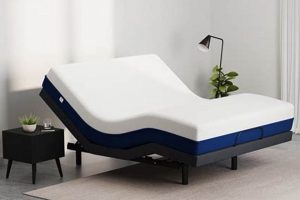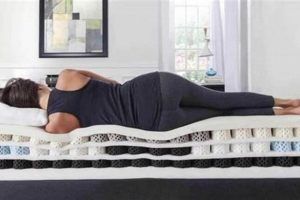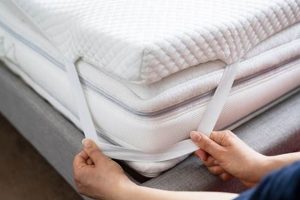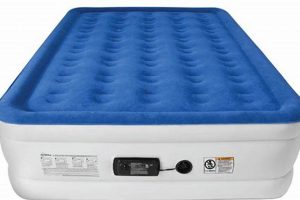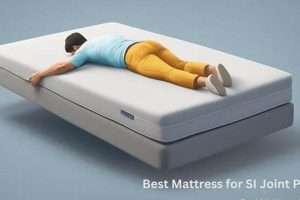The ideal sleep surface for two individuals prioritizes minimizing motion transfer, offering adequate support for varying body types and sleeping positions, and maintaining a comfortable temperature throughout the night. These characteristics are crucial for undisturbed rest when sharing a bed.
Selection of a compatible sleep surface can positively influence relationship quality by reducing sleep disruptions and improving overall well-being for both partners. Historically, considerations for shared sleep have evolved with advancements in materials and understanding of sleep science, leading to specialized products designed to address the unique needs of co-sleepers.
Subsequent sections will delve into specific mattress types, materials, and features that contribute to a superior shared sleep experience. Factors such as firmness levels, construction methods, and cooling technologies will be examined in detail to facilitate informed decision-making.
The selection of a shared sleep surface requires careful consideration of multiple factors to ensure optimal comfort and minimal sleep disruption for both individuals.
Tip 1: Assess Individual Firmness Preferences: Partners should identify their preferred firmness levels independently. Compromise may necessitate selecting a medium-firm option or exploring mattresses with customizable firmness zones.
Tip 2: Prioritize Motion Isolation: Mattresses constructed with individually wrapped coils or dense memory foam effectively minimize motion transfer, preventing disturbances caused by a partner’s movements.
Tip 3: Evaluate Edge Support: Strong edge support maximizes the usable sleep surface and prevents the sensation of rolling off the bed, particularly crucial for couples.
Tip 4: Consider Sleeping Positions: Side sleepers often benefit from softer surfaces that contour to the body, while back and stomach sleepers typically require firmer support to maintain spinal alignment.
Tip 5: Investigate Cooling Properties: Materials such as gel-infused memory foam, breathable fabrics, and open-cell structures can mitigate heat retention and promote a cooler sleep environment.
Tip 6: Research Mattress Types: Explore different mattress types, including innerspring, memory foam, latex, and hybrid models, to determine which best addresses individual needs and preferences.
Tip 7: Review Warranty and Trial Periods: Reputable manufacturers offer warranties and trial periods, allowing ample time to assess the mattress’s suitability and comfort level.
Implementing these guidelines facilitates the selection of a sleep surface that promotes restful, undisturbed sleep for both partners, thereby improving overall well-being and relationship harmony.
The following sections will explore specific product recommendations and address common concerns related to shared sleep surface selection.
1. Motion Isolation
Motion isolation is a critical attribute for a shared sleep surface, impacting the quality of rest experienced by both individuals. The primary function of motion isolation is to minimize the transfer of movement from one side of the bed to the other. A mattress lacking adequate motion isolation can result in one partner experiencing disturbances caused by the other’s tossing, turning, or getting in and out of bed. The absence of disruptive motion contributes directly to uninterrupted sleep cycles. For instance, a light sleeper sharing a bed with someone who frequently changes position throughout the night will benefit substantially from a mattress engineered with superior motion isolation capabilities.
Materials and construction techniques significantly influence motion isolation. Memory foam, with its ability to absorb and dampen movement, is frequently employed to achieve this effect. Individually wrapped coils, also known as pocketed coils, allow each spring to move independently, further reducing motion transfer compared to traditional innerspring systems. Conversely, mattresses with interconnected springs tend to transmit movement more readily. The effectiveness of motion isolation can be quantified using specialized testing equipment, which measures the degree of disturbance transmitted across the mattress surface. Real-world application includes couples where one partner works unconventional hours, thereby entering or exiting the bed at various times throughout the night.
Therefore, the selection of a sleep surface with demonstrable motion isolation properties constitutes a crucial element in fostering a restful sleep environment for couples. While other factors such as firmness and temperature regulation also play a role, minimizing motion transfer directly addresses a common source of sleep disruption in shared beds. Identifying mattresses with a high motion isolation rating becomes a practical imperative for couples prioritizing undisturbed sleep.
2. Firmness Compatibility
Firmness compatibility, concerning shared sleep surfaces, addresses the alignment of firmness preferences between two individuals. The selection of an appropriate mattress firmness is crucial because spinal alignment, pressure point relief, and overall comfort are directly influenced by this factor. When couples have disparate firmness preferences, one or both partners may experience discomfort, leading to disrupted sleep patterns and potential musculoskeletal issues. For example, one partner may prefer a soft mattress to alleviate pressure on joints, while the other may require a firm surface to support spinal alignment. This disparity presents a challenge in selecting a single mattress that meets both needs.
Solutions to this challenge include selecting a medium-firm mattress as a compromise, opting for a mattress with customizable firmness zones on each side, or considering mattresses with adjustable air chambers. The impact of incompatible firmness can manifest in various ways, including back pain, restless sleep, and difficulty falling asleep. In practical terms, if one partner experiences back pain on a too-soft mattress, while the other feels pressure points on a too-firm surface, neither will achieve optimal restorative sleep. Consequently, the selection process should prioritize an objective assessment of individual firmness needs through online tools, in-store trials, or professional consultation. Additionally, consideration should be given to the dominant sleeping position of each partner.
In summary, achieving firmness compatibility is an integral aspect of selecting a suitable sleep surface for couples. Failure to address this factor can lead to compromised sleep quality and long-term discomfort. Careful consideration of individual preferences, exploration of available options, and utilization of resources designed to facilitate informed decision-making are essential steps in ensurin
g a mutually beneficial sleep experience. This compatibility significantly contributes to the overall satisfaction and well-being of both individuals sharing the bed.
3. Temperature Regulation
Temperature regulation plays a crucial role in optimizing sleep quality, particularly for co-sleepers. A mattress’s ability to dissipate heat and maintain a comfortable sleeping temperature directly impacts the likelihood of undisturbed rest, making it a significant consideration in selecting a shared sleep surface.
- Material Breathability
The breathability of mattress materials is a primary determinant of temperature regulation. Materials like open-cell foam, latex, and natural fibers such as cotton and wool allow for greater airflow, facilitating heat dissipation. Conversely, dense memory foam can trap heat, potentially leading to discomfort and sleep disruption. For instance, a couple residing in a warmer climate would benefit significantly from a mattress constructed with breathable materials to prevent overheating during the night.
- Construction Design
Mattress construction also influences temperature regulation. Hybrid mattresses, which combine innerspring coils with layers of foam, often exhibit better airflow compared to all-foam mattresses. The coil system allows for greater ventilation, promoting heat transfer away from the body. The design ensures that heat does not accumulate within the mattress layers, resulting in a cooler sleeping surface.
- Cooling Technologies
Various cooling technologies are incorporated into mattresses to enhance temperature regulation. Gel-infused foams, phase-change materials, and specialized fabrics are designed to absorb and dissipate heat. These technologies actively regulate temperature, providing a cooler and more comfortable sleeping environment. A couple, where one partner tends to sleep hot, may find significant relief from a mattress incorporating such cooling technologies.
- Environmental Factors
External environmental factors interact with a mattress’s temperature regulation capabilities. Room temperature, bedding materials, and even the presence of moisture can influence the overall sleep climate. A mattress designed for temperature regulation can mitigate the effects of these external factors, maintaining a consistent and comfortable sleeping temperature. The effectiveness of a temperature-regulating mattress is also influenced by the ambient temperature of the bedroom. Thus, a holistic approach should consider these factors.
Collectively, these facets highlight the significance of temperature regulation in selecting a mattress for couples. By addressing heat retention and promoting a comfortable sleep climate, individuals can minimize sleep disruptions and improve overall rest quality. Prioritizing materials, construction, and technologies that facilitate temperature regulation is essential for achieving a shared sleep environment conducive to undisturbed and restful sleep.
4. Edge Support
Edge support, referring to the structural reinforcement along the perimeter of a mattress, directly influences the usable surface area and overall stability, representing a significant factor in the selection of a shared sleep surface. Adequate edge support mitigates the sensation of rolling off the mattress, particularly beneficial for couples who utilize the full width of the bed.
- Maximizing Usable Surface
Strong edge support effectively expands the usable sleep area of a mattress. Without sufficient reinforcement, the edges tend to compress under weight, creating a sloping effect. This compression reduces the available space and can lead to one or both partners feeling confined. In a shared sleep environment, maximizing the usable surface area ensures each individual has ample room to sleep comfortably without encroaching on the other’s space.
- Enhancing Stability and Support
Robust edge support contributes to the overall stability of the mattress. It prevents sagging and maintains consistent support across the entire surface, including the perimeter. This consistent support is particularly important for couples with varying body weights or sleeping positions. A mattress with weak edge support may exhibit uneven compression, leading to discomfort and potential spinal misalignment.
- Facilitating Ease of Entry and Exit
Solid edge support simplifies the process of getting in and out of bed. The reinforced perimeter provides a stable surface to sit on, reducing the strain on joints and muscles. This is especially relevant for individuals with mobility limitations or those who frequently enter and exit the bed during the night. A lack of edge support can make these actions more challenging and increase the risk of falls.
- Extending Mattress Lifespan
Adequate edge support can contribute to the longevity of the mattress. By preventing sagging and maintaining structural integrity, it prolongs the lifespan of the sleep surface. Mattresses with weak edge support tend to degrade more rapidly, leading to premature replacement. Investing in a mattress with reinforced edges can represent a cost-effective decision over time.
In conclusion, edge support is a critical feature that directly impacts the comfort, stability, and longevity of a shared sleep surface. By maximizing the usable area, enhancing stability, facilitating ease of movement, and extending the mattress lifespan, adequate edge support contributes significantly to a superior sleep experience for couples. Its presence is a key indicator of overall mattress quality and should be carefully evaluated when selecting a shared sleep surface.
5. Spinal Alignment
Spinal alignment represents a cornerstone of musculoskeletal health, directly influencing sleep quality and overall well-being, especially within the context of shared sleep environments. Selecting a mattress that promotes proper spinal alignment is crucial for minimizing discomfort and preventing long-term health issues for both partners.
- Maintaining Natural Curvature
Proper spinal alignment entails maintaining the natural curvature of the spine during sleep. This involves supporting the neck, back, and hips in a neutral position, preventing excessive pressure on any specific area. A mattress that fails to provide adequate support can lead to spinal misalignment, resulting in back pain, neck stiffness, and restricted movement. Consider a scenario where one partner sleeps on their side while the other sleeps on their back; a mattress accommodating both positions by contouring to the side sleeper while providing firm support for the back sleeper ensures optimal spinal alignment for each.
- Distributing Pressure Evenly
Effective spinal alignment necessitates even distribution of pressure along the spine. A mattress that conforms to the body’s contours reduces pressure points, preventing discomfort and promoting circulation. Conversely, a mattress that is either too firm or too soft can create pressure points, leading to
pain and disrupted sleep. Individuals experiencing sciatica, for example, require a mattress that minimizes pressure on the sciatic nerve to alleviate pain and promote restful sleep. - Accommodating Varying Sleeping Positions
Couples often exhibit diverse sleeping positions, necessitating a mattress capable of accommodating these variations. A versatile mattress should provide adequate support for back, side, and stomach sleepers, maintaining spinal alignment regardless of the chosen position. A hybrid mattress, combining the support of innerspring coils with the contouring of memory foam, represents a viable option for couples with differing sleeping preferences. This versatility ensures that both partners receive the necessary support to maintain proper spinal alignment.
- Preventing Long-Term Musculoskeletal Issues
Consistent spinal misalignment during sleep can contribute to chronic musculoskeletal issues, including back pain, sciatica, and arthritis. Selecting a mattress that promotes proper alignment can mitigate the risk of developing these conditions. Early intervention, such as choosing a supportive mattress, can prevent the progression of musculoskeletal problems and improve long-term health. Prioritizing spinal alignment in mattress selection represents a proactive approach to maintaining musculoskeletal well-being.
These interconnected facets underscore the importance of spinal alignment in the context of shared sleep surfaces. By prioritizing a mattress that supports natural spinal curvature, distributes pressure evenly, accommodates diverse sleeping positions, and prevents long-term musculoskeletal issues, couples can significantly enhance their sleep quality and overall health. The selection process should involve a careful assessment of individual needs and preferences, ensuring that the chosen mattress promotes optimal spinal alignment for both partners.
6. Durability
Durability, concerning sleep surfaces for co-sleepers, directly influences the long-term value and consistent support offered by the mattress. A durable mattress maintains its structural integrity and performance characteristics over an extended period, resisting sagging, indentation, and degradation of materials. The connection between durability and the suitability of a mattress for couples is significant because shared sleep environments often involve higher levels of use and weight distribution compared to single-occupancy beds. Consequently, a less durable mattress may exhibit premature wear and tear, compromising support and comfort for both individuals.
The selection of high-quality materials and robust construction techniques directly contributes to mattress durability. For instance, mattresses constructed with high-density foams, reinforced coil systems, and durable fabrics are inherently more resistant to degradation. In contrast, mattresses utilizing low-density materials or substandard construction may experience sagging or loss of support within a relatively short timeframe. Consider a couple who collectively weigh over 300 pounds: a mattress designed with reinforced edge support and high-density comfort layers will likely provide consistent support and maintain its shape for a longer duration compared to a mattress lacking these features. Regular rotation of the mattress can also help to evenly distribute weight and minimize localized wear.
In conclusion, durability is a critical attribute in the selection of a shared sleep surface. The longevity and consistent performance of a durable mattress translate directly to improved sleep quality, reduced replacement costs, and sustained comfort for both partners. While factors such as firmness, motion isolation, and temperature regulation are also important, the ability of a mattress to withstand the rigors of shared use without significant degradation is a fundamental aspect of its long-term value. Therefore, prioritizing durability through careful material selection and evaluation of construction techniques represents a prudent investment in a shared sleep environment.
This section addresses common inquiries and misconceptions surrounding mattress selection for couples, providing clarity on key considerations and best practices.
Question 1: What mattress type is generally considered most suitable for couples with differing sleep preferences?
Hybrid mattresses, combining innerspring coils with foam layers, often provide a balance of support and comfort, accommodating varied sleeping positions and firmness needs.
Question 2: How critical is motion isolation in a mattress designed for co-sleepers?
Motion isolation is paramount. Mattresses with superior motion isolation minimize disturbances from a partner’s movements, promoting uninterrupted sleep cycles.
Question 3: Is a higher price point always indicative of superior mattress quality and durability?
A higher price does not unequivocally guarantee superior quality. Factors such as materials, construction, and warranty should be carefully evaluated, irrespective of price.
Question 4: What role does temperature regulation play in shared sleep environments?
Temperature regulation is essential. Mattresses with breathable materials and cooling technologies mitigate heat retention, fostering a comfortable sleep climate for both individuals.
Question 5: How often should a mattress be rotated or flipped to ensure even wear?
Mattress rotation, typically every three to six months, is recommended to distribute weight evenly and prevent localized sagging. Flipping may be applicable depending on the mattress construction.
Question 6: What recourse is available if a newly purchased mattress proves unsuitable for a couple’s needs?
Reputable manufacturers typically offer trial periods, allowing returns or exchanges within a specified timeframe. Review the warranty and return policies prior to purchase.
The key takeaways emphasize the importance of prioritizing motion isolation, considering individual firmness needs, and evaluating mattress durability and temperature regulation capabilities. Informed decision-making significantly enhances the likelihood of selecting a shared sleep surface that promotes restful and undisturbed sleep.
The subsequent sections will delve into specific product recommendations and comparative analyses to facilitate a more informed purchase decision.
The preceding exploration of the “best mattress for couples” has underscored the multifaceted nature of selecting a sleep surface optimized for shared occupancy. Critical factors such as motion isolation, firmness compatibility, temperature regulation, edge support, spinal alignment, and durability collectively influence the quality of rest and overall well-being of both individuals. Effective mitigation of motion transfer, accommodation of disparate comfort preferences, and sustained structural integrity are paramount considerations in this decision-making process.
Recognizing the significance of these factors empowers individuals to make informed choices, ensuring a harmonious and restorative shared sleep environment. Continuous advancements in materials and sleep technology promise further refinements in mattress design, potentially offering even more tailored solutions to the unique challenges faced by co-sleepers. A thorough evaluation of individual needs, coupled with a comprehensive understandin
g of available mattress features, remains essential for achieving optimal sleep quality and relationship harmony.


![Top-Rated Best Mattress for Pack N Play - [Year] Review Organic & Natural Mattress Buyer’s Guide: Non-Toxic Sleep Solutions Top-Rated Best Mattress for Pack N Play - [Year] Review | Organic & Natural Mattress Buyer’s Guide: Non-Toxic Sleep Solutions](https://mattressworldpa.com/wp-content/uploads/2025/07/th-7612-300x200.jpg)
